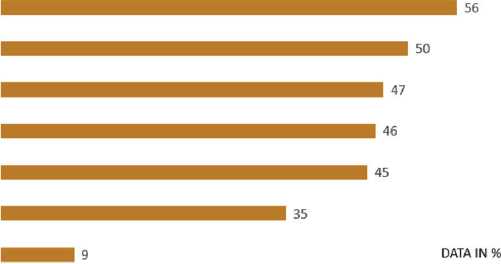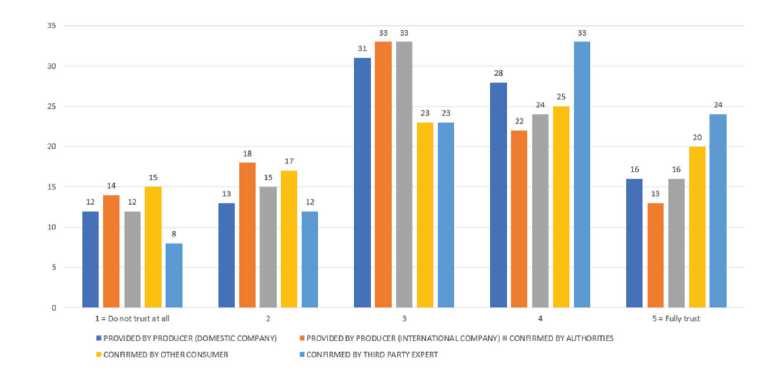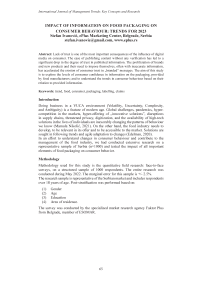Impact of information on food packaging on consumer behaviour: trends for 2023
Автор: Stefan Ivanović
Журнал: International Journal of Management Trends: Key Concepts and Research @journal-ijmt
Статья в выпуске: 1 vol.1, 2022 года.
Бесплатный доступ
Lack of trust is one of the most important consequences of the influence of digital media on consumer. The ease of publishing content without any verification has led to a significant drop in the degree of trust in published information. The proliferation of brands and new products and their need to impose themselves, often with inaccurate information, has accelerated the erosion of consumer trust in „branded” messages. The aim of this study is to explore the levels of consumer confidence in information on the packaging, provided by food manufacturers; and to understand the trends in consumer behaviour based on their relation to provided information.
Trend, food, consumer, packaging, labelling, claims
Короткий адрес: https://sciup.org/170204009
IDR: 170204009 | DOI: 10.58898/ijmt.v1i1.65-71
Текст научной статьи Impact of information on food packaging on consumer behaviour: trends for 2023
In an effort to understand changes in consumer behaviour and contribute to the management of the food industry, we had conducted extensive research on a representative sample of Serbia (n=1000) and tested the impact of all important elements of food packaging on consumer behavior.
Methodology
Methodology used for this study is the quantitative field research: face-to-face surveys, on a structured sample of 1000 respondents. The entire research was conducted during May 2022. The marginal error for this sample is +/- 2.5%.
The research sample is representative of the Serbian market and includes respondents over 18 years of age. Post-stratification was performed based on:
-
(1) Gender
-
(2) Age
-
(3) Education
-
(4) Area of residence.
The survey was conducted by the specialized market research agency Faktor Plus from Belgrade, member of ESOMAR.
Scope of Research Study
The point of sale is one of the most important brand touch-points between product and the consumer (Huré, Picot-Coupey andAckermann, 2017). About 70% of purchase decisions are made at the point of sale (Ståhlberg and Maila, 2012). Packaging, especially when it comes to food products, is one of the key elements that influences the decision to buy a product. The function of packaging is not only to protect the product and make it more visible, but also to provide information to the consumer about the product. The legal system determines which information must be listed on the packaging, while manufacturers put additional information, in accordance with their communication and marketing goals.
We wanted to explore the impact of various types of information provided on the packaging of food products and understand the attitudes of consumers towards them.
Results
Understanding the Information
The starting question was: Do you understand the information provided on the packaging? To this question, 26% of respondents answered that they understood, 25% that they did not understand, and 49% that they partially understood what the manufacturers were telling them. Also, the presence of children in the households influences the respondents to pay more attention and try to interpret and better understand the information on the packaging.
Table 1. Do you understand the information provided on the packaging?
|
Respondent s with children in |
People who eat healthily (1) not at all - (5) very healthily) |
|
|
15 |
household |
|
|
5 |
о |
|
|
Yes |
26 |
29 |
24 |
6 |
12 |
19 |
39 |
51 |
|
Partially |
49 |
53 |
48 |
35 |
53 |
60 |
50 |
37 |
|
No |
25 |
18 |
28 |
59 |
35 |
20 |
11 |
13 |
Total: 100
By cross-checking the data, we found that people who claim to eat healthily and take care of their nutrition, understand the information on the packaging much better than others. 51% of people who declare that they eat healthily understand all the information on the packaging, while of those who claim that they do not take care of their diet, only 13% of them understand the information. Comprehension of information increases with the degree of professional education, while it decreases with age - older groups of respondents understand nutritional information less than younger ones.
Table 2. Do you understand the information provided on the packaging?
|
Gender 5 E |
st m oo |
Age 01 st St ID 6 m m |
О 00 in |
|
Education > о c in 0 O r S « Ш V) I |
> Ё |
|||||
|
Yes |
26 |
20 |
30 |
30 |
26 |
22 |
18 |
13 |
17 |
30 |
35 |
|
Partially |
50 |
48 |
51 |
47 |
56 |
54 |
42 |
31 |
56 |
41 |
48 |
|
No |
25 |
32 |
19 |
23 |
19 |
24 |
39 |
56 |
26 |
30 |
16 |
Total
Level of Trust in Information
Very similar results are obtained regarding the trust in provided information. Groups of consumers who have a higher level of comprehension also have more trust in information. The conclusion is that those consumers who pay more attention to study the information, have also higher degree of trust, while older people and those with less formal education understand less, and they have less trust in the information provided by the manufacturer. We also notice that female consumers pay more attention and have more trust in information on food packaging than male consumers.
Table 3. Do you trust the information provided on the packaging?
|
Gender |
Age |
Education |
|||||||
|
о |
fl |
5 2 |
0 Q |
||||||
|
8 |
5 |
% 3 |
Ф E Ш |
£ z |
1 |
||||
|
Yes |
17 |
14 |
20 |
19 |
18 |
19 |
10 |
6 |
13 |
12 |
27 |
|
Partially |
58 |
54 |
61 |
55 |
63 |
61 |
55 |
38 |
61 |
56 |
58 |
|
No |
13 |
16 |
10 |
13 |
10 |
9 |
21 |
13 |
12 |
23 |
8 |
|
1 don't read info |
12 |
IS |
9 |
13 |
10 |
11 |
14 |
44 |
14 |
9 |
7 |
Total: 100
Form of Information
In the last decades, there has been a noticeable trend of emphasizing nutritional information in a visually attractive way, in the form of various symbols and icons (Keller et al., 1997). The aim of this type of communication applied by manufacturers is to stand out from the group and to highlight some of their advantages compared to other products.
Table 4. Do you prefer that information about the product to be presented as an overview table or designed as visual symbols?
|
га о |
Gender CD ro E |
m 00 |
Age cn ID tn 6 rn in |
О °? LG ID |
П5 C CD E CD LU |
Education о ^ о c ° to ° о о T о СП |
CD > |
||||
|
Both |
41 |
34 |
47 |
39 |
49 |
37 |
39 |
38 |
38 |
43 |
46 |
|
Just the table |
24 |
23 |
24 |
19 |
24 |
27 |
31 |
19 |
24 |
21 |
25 |
|
Just symbols |
11 |
11 |
11 |
11 |
13 |
10 |
10 |
13 |
11 |
12 |
10 |
|
Information is not necessary |
5 |
7 |
4 |
7 |
4 |
5 |
4 |
13 |
6 |
6 |
3 |
|
1 don't know |
18 |
25 |
14 |
24 |
11 |
21 |
15 |
19 |
21 |
17 |
16 |
Total: loo
What we wanted to find out is whether consumers prefer overview tables with important information or if they pay more attention to information presented using visual symbols. In the vast majority, consumers want to have both data views available: tabular and through symbols. Symbols draw their attention to product features that are important to them, but they often do not contain all the important information, so they want to check the information in tables which contain precise information.
Trust in brands
Highlighting the manufacturer’s brand logo on the packaging is used by almost all companies from the food industry (Keller et al., 1997). The goal of this tactic is to transfer brand features to the respective products. In a world of great competition at every point of sale, we were interested in what kind of brands consumers trust, when it comes to food products.
Table 5. What brands do you trust most?
|
ГО о |
Gender |
co |
Age |
О 00 15 |
1 |
Education >- о ™ о i |
|||||
|
Well known and has long tradition |
64 |
64 |
65 |
57 |
66 |
68 |
75 |
63 |
65 |
69 |
61 |
|
Bra nd that advertise in media |
5 |
4 |
6 |
6 |
4 |
6 |
6 |
13 |
5 |
5 |
5 |
|
Brand whose packaging a re fa n cy a n d attra ctive |
13 |
11 |
15 |
18 |
10 |
10 |
10 |
0 |
8 |
11 |
21 |
|
Bra nds that clearly provides im portant info about products |
43 |
39 |
46 |
42 |
47 |
45 |
38 |
6 |
37 |
47 |
53 |
|
Brand which is part of my life, of my community |
27 |
27 |
28 |
29 |
23 |
37 |
18 |
25 |
29 |
21 |
29 |
|
It's products are not cheap, high price means better quality |
10 |
8 |
11 |
8 |
10 |
10 |
13 |
31 |
7 |
12 |
10 |
|
Is available in my favorite shop |
18 |
19 |
17 |
22 |
12 |
15 |
21 |
31 |
20 |
19 |
14 |
|
Other |
3 |
6 |
2 |
4 |
5 |
1 |
1 |
6 |
3 |
5 |
3 |
The most important characteristic of a brand in which consumers have confidence is tradition and persistence on the market for a long period of time. The importance of tradition and constancy increases with the age of the respondents so that it is the most important for 75% of the oldest surveyed group (65-80), while the same characteristic is the most important for 57% of the respondents in the group (18-34). Another characteristic that stood out is that consumers trust brands that clearly state product information on the packaging (most important for 43% of consumers).
Relevant information
Food manufacturers use different tactics to achieve their marketing and sales goals. Changes in product quality, net weight, production by third parties (private label products), highlighting data that often have no real benefits, or even that aim to divert attention from some shortcomings, have had a significant impact on consumer confidence and their behaviour (Hapsoro and Hafidh, 2018). We wanted to find out which information is relevant and should be prominently displayed on the packaging.
NET WEIGHT
SUGAR AND FAT CONTENT
ALL IMPORTANT INFO
SHOUD BE HIGHLIGHTED
PRODUCER
COUNTRY OF ORIGIN
CALORIES
OTHER

0 10 20 30 40 50 60
Figure 1. Which information is to be highlighted or food packaging?
The majority of consumers believe that the net weight should be visibly highlighted (56%), followed by the sugar and fat content (50%). Further, there are three answers with approximately equal values. These are the info on the manufacturer (46%), the country-of-origin info (45%) and 47% of respondents who believe that all important information must be equally visible.
Origin and source of information
We wanted to examine the correlation between the trust that a brand enjoys in the market, depending on whether it is a domestic or an international company. Further, given the growing crisis of trust in brands, and trust in brands, as one of the leading motivators for purchase, manufacturers often seek to add credibility to their information by engaging third parties to corroborate their claims.

Figure 2. What is your trust level in information on food packaging if provided by?
Consumers on the Serbian market have more confidence in the claims on the packaging when they are made by domestic companies (44%) than when they are made by international companies (35%). Trust levels vary if are confirmed by another consumer (40%), a state authority (45%), and the highest degree of trust in claims on food packaging is when they are confirmed by independent experts (57%).
Conclusion
The study shows which information on packaging can influence consumer attitudes that influence their behaviour when purchasing food products. Certain information is more important for certain groups of consumers, and it is recommended for manufacturers to pay attention to the above findings in order to offer relevant information to their target market.
The key finding is that relevant information must be listed clearly, clearly and unambiguously, in a visible and comprehensible way. Information that should be paid special attention to, so that manufacturers can influence the market, concerns the characteristics of the products themselves, the geographical origin of the company. Brands that are consistent and truthful in their labelling communication, can count on a higher degree of consumer trust, greater brand loyalty and higher conversion rates that lead to sales decisions. Endorsing the information by other consumers, authorities or independent experts increase level of trust in provided information.
Список литературы Impact of information on food packaging on consumer behaviour: trends for 2023
- Edelman (2020). Brand Trust in 2020: Special Report. Edelman Trust Barometar. Available at: https://www.edelman.com/sites/g/files/aatuss191/files/2020-06/2020%20Edelman%20 Trust%20Barometer%20Specl%20Rept%20Brand%20Trust%20in%202020.pdf
- Hapsoro, B. B., & Hafidh, W. A. (2018). The influence of product quality, brand image on purchasing decisions through brand trust as mediating variable. Management Analysis Journal, 7(4), 528-539.
- Huré, E., Picot-Coupey, K., & Ackermann, C. L. (2017). Understanding omni-channel shopping value: A mixed-method study. Journal of retailing and consumer services, 39, 314- 330.
- Keller, S. B., Landry, M., Olson, J., Velliquette, A. M., Burton, S., & Andrews, J. C. (1997). The effects of nutrition pack-age claims, nutrition facts panels, and motivation to process nutrition information on consumer product evaluations. Journal of Public Policy & Marketing, 16(2), 256-269.
- Mamula Nikolić, T. (2021). Nova generacija potrošača i lidera u VUCA svetu: ponašanje potrošaca i lidera Y i Z genera-cije u VUCA svetu: “Šta ima tu za mene” generacija. iLearn
- Ståhlberg, M., & Maila, V. (2012). Shopper marketing: How to increase purchase decisions at the point of sale. Kogan Page Publishers.


